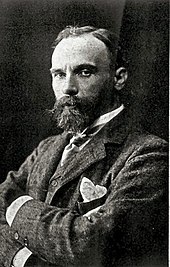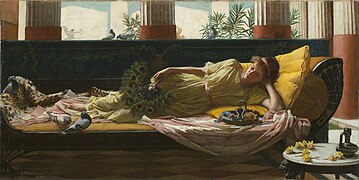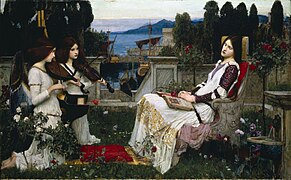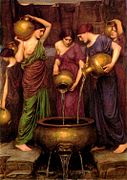John William Waterhouse
John William Waterhouse RA (born April 6, 1849 in Rome , † February 10, 1917 in London ) was a British painter who is attributed to both academic realism and the group of the Pre-Raphaelites .
Life
Waterhouse was born in Rome to the painter William Waterhouse and his wife, the painter Isabella . He was called "Nino" by his family and friends, the diminutive of the Italian given name Giovanino. In 1854 his family moved to London. In 1857 his mother and brother died of tuberculosis. His father remarried in 1860, Frederica Mary Jane Perceval, the granddaughter of the British Prime Minister, Spencer Perceval , who was assassinated . After he was first taught by his father, in 1871 - after several unsuccessful attempts - he became a student of sculpture (sculpture) at the schools of the Royal Academy. As early as 1872 Waterhouse exhibited in the Royal Society of British Artists . It is believed that his sister Jessica was one of his earliest models. In 1874, at the age of twenty-five, Waterhouse submitted the classic allegory of Sleep and His Half-Brother's Death for the Royal Academy of Arts Summer Exhibition .
Waterhouse was the successor to the generation of painters who z. B. was dominated by Frederic Leighton , George Frederic Watts , Edward Burne-Jones and Lawrence Alma-Tadema . He took his inspiration from many of these great Victorian painters and developed from them his own style in which classicism, romanticism, fantasy and reality are interwoven. He was less concerned with delicacy than his Victorian ancestors, while he owed the Pre-Raphaelites his subjects and richness of color, but not the degree of perfection. Some of the landscapes in his paintings resemble those of the Impressionists .
His early works were exhibited at the Royal Academy of Arts , the Royal Society of British Artists , the Royal Institute of Painters in Water Colors and the Dudley Gallery .
Waterhouse loved Italy and spent a lot of time there between 1876 and 1883 painting genre pictures.
In 1883 he married Esther Kenworthy, daughter of an art school teacher, at St. Michael's Church in Ealing . Two children were born and both died early. In 1877 the architect Alfred Healy had built a series of houses with studios in Primrose Hill for 12 artists. Waterhouse moved in there with his wife and associated with members of the Newlyn School , which was influenced by France.
Although he mainly painted in oils, he was elected to the Royal Institute of Painters in Water Colors in 1883 but resigned in 1889.
He followed the conventional path to success by being elected ARA (Associate) of the Royal Academy on June 4, 1885 and ten years later on May 16, 1895 as a full member of the RA (Royal Academician). His thesis for the RA was “A Mermaid” (A Mermaid). Because the painting was not completed until 1900, Waterhouse offered his "Ophelia" from 1888 as a temporary submission to the Royal Academy.
The Boer War began in South Africa in 1899 and in the spring of 1900, 350 artists gave their works to the "Artists' War Fund" to support British troops, which had been founded especially for this purpose and Waterhouse was one of the primary donors. For this he created the painting “Fate”. The pictures offered to the war fund were auctioned off by the Christies auction house and the proceeds were transferred to the war fund.
His most famous painting is considered The Lady of Shalott ( The Lady of Shalott) , which was purchased by Sir Henry Tate in 1888; the first of the three versions was created in 1888. He was inspired by the poem of the same name by Alfred Lord Tennyson .
In 1901 he moved to St Johns Wood and joined the St. Johns Wood Arts Club, a social organization that included Lawrence Alma-Tadema and George Clausen (1852-1944).
One of his last works was The Enchanted Garden , left unfinished on his easel when he died, and is now in the collection of the Lady Lever Art Gallery in Bebington .
John William Waterhouse died of cancer on February 10, 1917, at the age of nearly 68 at his home in St. John's Wood, London. He found his final resting place in Kensal Green Cemetery in London. His wife Esther survived him by 27 years and died in 1944. She was buried next to him.
reception
“The critics were sometimes euphoric and sometimes devastating about the offspring of Waterhouse. One critic complained that the personalities in his pictures did not come from “dreams or daylight”; another raved that Waterhouse art lived “in a world that it created itself”. So everyone agreed on one point: The painter, born in Rome in 1847, had created a world that could not be assigned to either the fantastic or the reality. In his painting, witches, hybrids and fairy tale characters received a new home. He was a master at giving the extraordinary a casual, natural shape. "
Picture gallery (selection)
Eurydice (1880)
Diogenes (1882)
The Favorites of the Emperor Honorius (1883)
The Lady of Shalott (1888)
Circe Invidiosa (1892)
Cecilia of Rome (1895)
Flora and the Zephyre (1898)
The Mermaid (1900)
The Danaids (1903)
Boreas (1903)
Decamerons (1916)
Miranda - The Tempest (1916), inspiration for the music video Frozen by Madonna
Trivia
The picture Hylas and the Nymphs exhibited in Manchester was temporarily removed as part of the metoo sexism debate in order to initiate a discussion about the roles of women in art.
literature
- Peter Trippi: JW Waterhouse , London [u. a.]: Phaidon, 2011, ISBN 978-0-7148-4518-0
Web links
- Literature by and about John William Waterhouse in the catalog of the German National Library
- Search for John William Waterhouse in the SPK digital portal of the Prussian Cultural Heritage Foundation
- John William Waterhouse on kunstaspekte.de
- John William Waterhouse.net around 200 paintings
- Pictures from Waterhouse A – Z
- John William Waterhouse (German)
- Picture gallery of The Athenaeum (English)
- The Art of John William Waterhouse (English)
- Waterhouse exhibition at the Royal Academy of Arts, London, from June 27th to September 13th, 2009
- Review of Julia Voss' exhibition in the FAZ
- Picture review The Lady of Shallot (English)
Individual evidence
- ^ The RA Schools
- ↑ Sleep and His Half Brother Death ( Memento of the original from September 9, 2009 in the Internet Archive ) Info: The archive link was inserted automatically and has not yet been checked. Please check the original and archive link according to the instructions and then remove this notice.
- ↑ Portrait of Esther Kenworthy Waterhouse ( Memento of the original dated December 3, 2009 in the Internet Archive ) Info: The archive link was inserted automatically and has not yet been checked. Please check the original and archive link according to the instructions and then remove this notice.
- ^ Diploma Work given by John William Waterhouse, RA, accepted 1901
- ^ "Destiny" - today: The Towneley Hall Art Gallery and Museums - Burnley, England
- ^ George Clausen paintings on BBC
- ↑ The Enchanted Garden
- ↑ Sexism debate: Manchester museum hangs up paintings
| personal data | |
|---|---|
| SURNAME | Waterhouse, John William |
| BRIEF DESCRIPTION | British academic realism and Pre-Raphaelite painter |
| DATE OF BIRTH | April 6, 1849 |
| PLACE OF BIRTH | Rome |
| DATE OF DEATH | February 10, 1917 |
| Place of death | London |

















